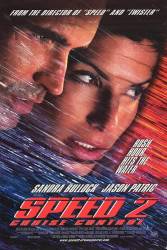Factual error: In one scene they attempt to divert the ship by manually activating the ship's bowthruster. A thruster is a propeller in a transverse direction. This allows the ship to turn more efficiently when docking. However the thruster loses any efficiency above approximately 5 knots. In the film they use it at 17 knots. Secondly, a thruster is powered by an electric motor of at least 500 kW, yet they manage to turn it by hand. That handle does not exist in real life, and no one would be able to turn it anyway.
Factual error: You cannot walk into a ballast tank from the accommodation areas. The tanks are not painted white on the inside, and electric lights are not installed in ballasttanks. And finally, when filling ballasttanks, it is done through a pipe and a pump, not by opening gigantic doors in the ship's hull.
Factual error: No ship has ever been - or ever will be built without having emergency fuel shutoff devices that can be manually operated.
Suggested correction: Yes, but the fuel shut off valves would have been located in the engine room. The doors to the engine room had been locked by the bad guy.
Not only in the engine room but also at the bridge and most probably the steering gear room as well.
Factual error: In the scene where Dafoe is escaping in the hydro-plane with Bullock, it takes an extremely long time to take off. Those kind of planes needs 800-900 meters to achieve the necessary speed, taking about 45 sec., while the scene lasts almost 2 minutes.
Factual error: Near the end, the starboard anchor runs out, into a car on the pier. The anchor chain on a normal vessel of that size is about 300 meters long, and fastened to the vessel at the end, in the bottom of the so-called chain-locker. And the anchor does not come out of the ship in a roll lead, it has its own opening in the hull.
Factual error: When Willem Dafoe places the devices on the bridge, all lights are on. It is night outside, and if all lights are on inside, you can't see anything outside. All you will see, is your own reflection in the window.
Factual error: The Eindhoven Lion exploding should almost be akin to a nuclear bomb going off. The boat they escape on would have been incinerated from the blast, or at the very least blown off the water.
Factual error: At this time, there was no way that you could take full control of a ship's engine, navigation, fire fighting systems etc. remotely.
Factual error: The "Seabourn Legend" makes 19 knots at full sea speed. After Geiger fails one of the engines she still makes 18 knots while headed for the "Eindhoven Lion." With only one screw active and one engine out of order, that wouldn't be possible.
Factual error: The boat used by Bullock and Defoe to get off the cruise ship is water jet powered. The boat is shown launching from a dry dock and into the water using its engine. This is impossible. The only way for a water jet powered boat to accelerate is to be in the water.





